 W
WA cavalcade is a procession or parade on horseback, or a mass trail ride by a company of riders. The focus of a cavalcade is participation rather than display. Often, the participants do not wear costumes or ride in formation. Often, a cavalcade re-enacts an important historical event and follows a long-distance trail. A cavalcade may also be a pilgrimage.
 W
WChagu Chagu Umakko (チャグチャグ馬コ) is a horse festival in Iwate Prefecture, Japan. Held on the second Saturday in June, approximately one hundred horses with colourful fittings and bells parade between Sozen Shrine in Takizawa and Morioka Hachiman-gū. The term chagu-chagu is an onomatopoeic expression for the sound made by the horses' bells. In 1978 the festival was recorded as an Intangible Folk Cultural Property. In 1996 the sound of the bells of the Chagu Chagu Umakko was selected by the Ministry of the Environment as one of the 100 Soundscapes of Japan.
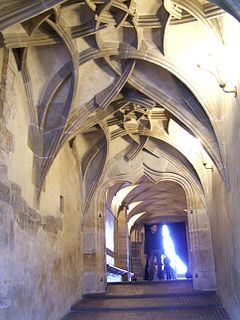 W
WAn equestrian staircase or riders' staircase is a very gently sloping flight of steps that can be negotiated by horses. Its origins may be seen in the mule staircases in steep terrain in open country.
 W
WHestavíg was an entertainment activity during the Viking Age in the Icelandic Commonwealth (930–1262), presumably a sport consisting of a brutal and bloody confrontation between two stallions, egged on by their masters, which mainly served to choose the best specimens for breeding. It was a cultural event of great importance and sometimes behaved verbal and physical confrontations among the spectators. The triumph of a champion or the other could impact socially and politically in the pacts and alliances between goði (chieftains) and bóndi (homesteaders), as testified in the Norse sagas. The site where these battles held was a neutral place used to strengthen friendship or treat issues among rivals. It was also an opportunity for courtship between young couples. Sometimes rivalries raised among participants and ended in bloody conflicts. Some examples appear in the Njáls saga and Víga-Glúms saga.
 W
WHorse burial is the practice of burying a horse as part of the ritual of human burial, and is found among many Indo-European peoples and others, including Chinese and Turkic peoples. The act indicates the high value placed on horses in the particular cultures and provides evidence of the migration of peoples with a horse culture. Human burials that contain other livestock are rare; in Britain, for example, 31 horse burials have been discovered but only one cow burial, unique in Europe. This process of horse burial is part of a wider tradition of horse sacrifice. An associated ritual is that of chariot burial, in which an entire chariot, with or without a horse, is buried with a dead person.
 W
WHorses play a large role in the daily and national life of the Mongols; it is traditionally said that "A Mongol without a horse is like a bird without the wings." Elizabeth Kimball Kendall, who travelled through Mongolia in 1911, observed, "To appreciate the Mongol you must see him on horseback,—and indeed you rarely see him otherwise, for he does not put foot to ground if he can help it. The Mongol without his pony is only half a Mongol, but with his pony he is as good as two men. It is a fine sight to see him tearing over the plain, loose bridle, easy seat, much like the Western cowboy, but with less sprawl.".
 W
WThe horse head mask is a latex mask representing a horse head originally manufactured by novelty purveyor Archie McPhee, and now widely available from other manufacturers. The mask covers the entire head and is typically part of a Halloween costume, or at other times to be funny, shocking, incongruous, or hip, or to disguise one's identity. It has also become an internet meme.
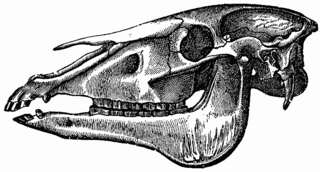 W
WIn Ireland, England, Wales, and the Scandinavian Peninsula, the skulls of horses have been found concealed in the structures of buildings, usually under the foundation or floor. Horse skulls have also been found in buildings in the United States, although in far fewer numbers. As part of the larger folk tradition of concealing objects in structures, horse skulls are related to concealed shoes, dried cats, and witch bottles.
 W
WTwelve U.S. states have designated a horse breed as the official state horse. The first state horse was designated in Vermont in 1961. The most recent state designations occurred in 2010, when North Carolina and South Carolina both declared state breeds. There have been proposals to designate a state horse in Oregon as well as in Arizona, but neither proposal is yet successful. In one state, North Dakota, the state horse is officially designated the "honorary state equine." Two additional states have not designated a specific state horse, but have designed a horse or horse breed as its official state animals: the horse in New Jersey and the Morgan horse breed in Vermont.
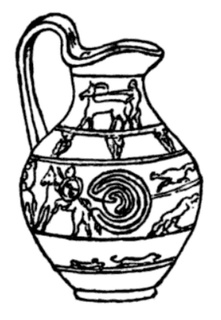 W
WThe Lusus Troiae, also as Ludus Troiae and ludicrum Troiae was an equestrian event held in ancient Rome. It was among the ludi ("games"), celebrated at imperial funerals, temple foundings, or in honor of a military victory. The lusus was occasionally presented at the Saecular Games, but was not attached regularly to a particular religious festival.
 W
WThe Mari Lwyd is a wassailing folk custom found in South Wales. The tradition entails the use of an eponymous hobby horse which is made from a horse's skull mounted on a pole and carried by an individual hidden under a sackcloth. It represents a regional variation of a "hooded animal" tradition that appears throughout Great Britain.
 W
WIn the coastal town of Minehead, located in the southwest English county of Somerset, there is a folk custom on May Day entailing the parading of a brightly decorated hobby horse around the locality.
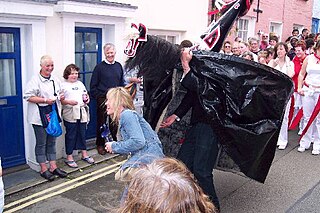 W
WThe 'Obby 'Oss festival is a folk custom that takes place each May Day in Padstow, a coastal town in North Cornwall. It involves two separate processions making their way around the town, each containing an eponymous hobby horse known as the 'Obby 'Oss.
 W
WA riderless horse is a single horse, without a rider, and with boots reversed in the stirrups, which sometimes accompanies a funeral procession. The horse follows the caisson carrying the casket. A riderless horse can also be featured in military parades to symbolize fallen soldiers. In Australia for example, it is traditional for a riderless horse known as the 'Lone Charger' to lead the annual Anzac Day marches.
 W
WSutton Hoo near Woodbridge, in Suffolk, England, is the site of two early medieval cemeteries that date from the 6th to 7th centuries. Archaeologists have been excavating the area since 1939. One cemetery had an undisturbed ship burial with a wealth of Anglo-Saxon artefacts; most of these objects are now held by the British Museum. Scholars believe Rædwald of East Anglia to be the most likely the person buried in the ship. The site is important in understanding the Anglo-Saxon kingdom of East Anglia and the early Anglo-Saxon period, as it illuminates a period that lacks historical documentation.
 W
WThe Trojan Horse is a story from the Trojan War about the subterfuge that the Greeks used to enter the independent city of Troy and win the war. In the canonical version, after a fruitless 10-year siege, the Greeks constructed a huge wooden horse and hid a select force of men inside, including Odysseus. The Greeks pretended to sail away, and the Trojans pulled the horse into their city as a victory trophy. That night the Greek force crept out of the horse and opened the gates for the rest of the Greek army, which had sailed back under cover of night. The Greeks entered and destroyed the city of Troy, ending the war.
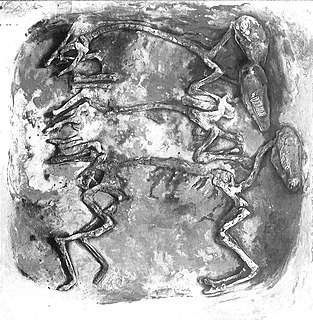 W
WThe Wulfsen horse burial is an early medieval horse burial, consisting of three horses, that was discovered in 1974 in a Saxon grave field in the village of Wulfsen, in the German district of Harburg. The find was rescued as a varnish profile, which is on display in the permanent exhibition of the Archaeological Museum Hamburg in Harburg, Hamburg.